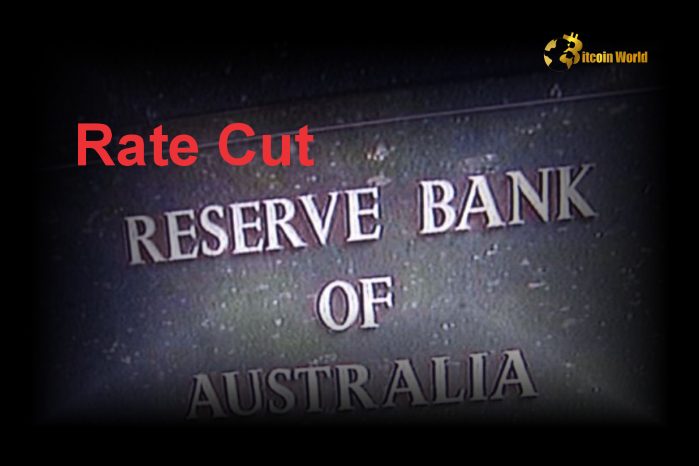In a move that has sent ripples through the forex market, the Reserve Bank of Australia (RBA) has delivered its first interest rate cut in four years. While the 25 basis point reduction itself was widely anticipated, the accompanying rhetoric from RBA Governor Michele Bullock has been anything but dovish. This unexpected ‘hawkish cut’ has left analysts and traders alike scrambling to reassess their Australian Dollar (AUD) outlook. Let’s dive into what this means for the AUD and what ING’s expert analysts are predicting.
Decoding the Hawkish RBA Rate Cut
The RBA’s decision to cut rates wasn’t a shocker, but the tone certainly was. Governor Bullock’s statements during the announcement and subsequent press conference emphasized a continued focus on inflation risks, pushing back against market expectations of further dovish policy. This stance is a stark contrast to other developed central banks who are increasingly showing concern about economic growth. So, what makes this rate cut ‘hawkish’?
- Inflation Focus: Despite cutting rates, Bullock stressed that inflation remains the primary concern. This signals that the RBA is not necessarily embarking on a prolonged easing cycle.
- Pushback on Dovish Expectations: The RBA actively attempted to temper market expectations of aggressive future rate cuts, suggesting a more cautious approach.
- Contrast with Global Central Banks: While others are leaning towards growth concerns, the RBA is holding firm on its inflation fight, at least for now.
This hawkish undertone has provided unexpected support to the Australian Dollar (AUD), which initially countered the typical strengthening of the US Dollar (USD) often seen after rate cuts. However, the question remains: can this hawkish stance sustain the AUD’s strength in the long run?
Australian Dollar Forecast: ING’s Perspective
ING’s FX analysts, led by Francesco Pesole, offer a compelling Australian Dollar forecast in light of this ‘hawkish cut’. Despite the RBA’s rhetoric, ING remains somewhat skeptical about a complete shift in market expectations. Here’s a breakdown of their analysis:
- Market Expectations vs. ING Forecast: Markets are currently pricing in just under two rate cuts in Australia by the end of 2025. ING, however, maintains a slightly more dovish outlook, forecasting one rate cut per quarter.
- Short-Term AUD Boost: Bullock’s cautious tone has indeed helped the AUD resist the strengthening USD, providing a temporary lift.
- Long-Term Headwinds: ING analysts doubt that markets will fully revise their expectations to just one RBA cut for the year. They believe the Australian Dollar’s high sensitivity to global trade dynamics and overall risk sentiment will eventually outweigh any short-term benefits from the RBA’s hawkish tone.
- AUD/USD Target: ING maintains its prediction for AUD/USD to return to 0.62 by the end of March. Furthermore, they foresee potential downside risks in the second and third quarters, particularly if US protectionist policies intensify.
In essence, while the ‘hawkish cut’ has provided a temporary boost to the AUD, ING suggests that fundamental economic factors and global market trends will likely exert more significant influence in the medium to long term. The Australian Dollar forecast, therefore, remains cautiously bearish.
Interest Rate Expectations and the AUD Trajectory
The divergence between market interest rate expectations and the RBA’s signaled intentions is a key factor influencing the Australian Dollar’s trajectory. If markets continue to price in more aggressive rate cuts than the RBA is willing to deliver, the AUD could face downward pressure. Conversely, if the RBA successfully convinces markets of its hawkish stance and limits rate cut expectations, the AUD might find stronger footing.
However, it’s crucial to remember that interest rate expectations are just one piece of the puzzle. Global economic conditions, commodity prices (Australia being a major commodity exporter), and geopolitical events all play a significant role in shaping the AUD’s value. The Australian Dollar forecast is therefore a complex interplay of domestic and international factors.
Navigating the AUD in a ‘Hawkish Cut’ Environment
For traders and investors navigating the forex markets, especially those interested in cryptocurrencies and their correlation with traditional markets, understanding the nuances of this ‘hawkish cut’ is vital. Here are some actionable insights:
- Monitor RBA Communications: Pay close attention to future statements and speeches from RBA officials for further clues about their policy intentions.
- Track Global Risk Sentiment: The AUD’s sensitivity to risk sentiment means that global events impacting market confidence will likely influence its value.
- Consider Commodity Prices: As a commodity currency, the AUD is often correlated with commodity prices, particularly those of iron ore and coal.
- Stay Informed on US Protectionism: Developments in US trade policy, especially concerning protectionism, could pose downside risks to the AUD, as highlighted by ING.
In conclusion, the RBA’s ‘hawkish cut’ has injected a degree of uncertainty and intrigue into the Australian Dollar outlook. While it has provided short-term support, the long-term trajectory of the AUD will depend on a complex interplay of factors, including actual RBA policy moves, market perceptions, global economic conditions, and risk sentiment. Investors should remain vigilant and adaptable as this situation unfolds.
To learn more about the latest Forex market trends, explore our article on key developments shaping interest rates and institutional adoption.
Disclaimer: The information provided is not trading advice, Bitcoinworld.co.in holds no liability for any investments made based on the information provided on this page. We strongly recommend independent research and/or consultation with a qualified professional before making any investment decisions.


